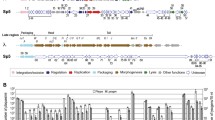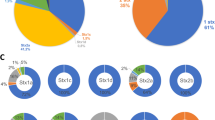Abstract
The bacteriophage VP3 is used in a phage-biotyping scheme as one of the typing phages of Vibrio cholerae O1 biotype El Tor strains. Here, we have sequenced and analyzed its genome. The genome consists of 39,481 bp with an overall G + C content of 42.6 %. Fifty-two open reading frames (ORFs) were predicted. Within the genome, 17 highly conserved phage promoters and 6 rho-independent terminators were predicted. When assessed with Rluc as a reporter gene, 12 of 16 cloned VP3 promoters showed activity in the host strain V. cholerae biotype El Tor. Based on the temporal expression pattern detected using reverse transcription PCR (RT-PCR), VP3 ORFs can be classed into four groups, arranged according to their order in the VP3 genome. Terminators T1 and T6 are presumed to work efficiently. Sequencing of the typing phage VP3 of V. cholerae reveals its evolutionary subdivisions from the members of T7-like phages of Escherichia coli. Knowledge of VP3 expands the known host range of T7-like phages and will promote understanding the different infection mechanisms used by members of this genus.





Similar content being viewed by others
References
Hardies SC, Comeau AM, Serwer P, Suttle CA (2003) The complete sequence of marine bacteriophage VpV262 infecting Vibrio parahaemolyticus indicates that an ancestral component of a T7 viral supergroup is widespread in the marine environment. Virology 310(2):359–371
Lavigne R, Seto D, Mahadevan P, Ackermann HW, Kropinski AM (2008) Unifying classical and molecular taxonomic classification: analysis of the Podoviridae using BLASTP-based tools. Res Microbiol 159(5):406–414
Pajunen MI, Elizondo MR, Skurnik M, Kieleczawa J, Molineux IJ (2002) Complete nucleotide sequence and likely recombinatorial origin of bacteriophage T3. J Mol Biol 319(5):1115–1132
Dunn JJ, Studier FW (1983) Complete nucleotide sequence of bacteriophage T7 DNA and the locations of T7 genetic elements. J Mol Biol 166(4):477–535
Scholl D, Merril C (2005) The genome of bacteriophage K1F, a T7-like phage that has acquired the ability to replicate on K1 strains of Escherichia coli. J Bacteriol 187(24):8499–8503
Garcia E, Elliott JM, Ramanculov E, Chain PS, Chu MC, Molineux IJ (2003) The genome sequence of Yersinia pestis bacteriophage phiA1122 reveals an intimate history with the coliphage T3 and T7 genomes. J Bacteriol 185(17):5248–5262
Pajunen MI, Kiljunen SJ, Söderholm ME, Skurnik M (2001) Complete genomic sequence of the lytic bacteriophage phiYeO3-12 of Yersinia enterocolitica serotype O:3. J Bacteriol 183(6):1928–1937
Kovalyova IV, Kropinski AM (2003) The complete genomic sequence of lytic bacteriophage gh-1 infecting Pseudomonas putida-evidence for close relationship to the T7 group. Virology 311(2):305–315
Korsten KH, Tomkiewicz C, Hausmann R (1979) The strategy of infection as a criterion for phylogenetic relationships of non-coli phages morphologically similar to phage T7. J Gen Virol 43(1):57–73
Chen Z, Schneider TD (2005) Information theory based T7-like promoter models: classification of bacteriophages and differential evolution of promoters and their polymerases. Nucleic Acids Res 33(19):6172–6187
Feeley JC (1965) Classification of Vibrio cholerae (Vibrio comma), including El Tor vibrios, by infrasubspecific characteristics. J Bacteriol 89:665–670
Guidolin A, Morelli G, Kamke M, Manning PA (1984) Vibrio cholerae bacteriophage CP-T1: characterization of bacteriophage DNA and restriction analysis. J Virol 51(1):163–169
Reidl J, Mekalanos JJ (1995) Characterization of Vibrio cholerae bacteriophage K139 and use of a novel mini-transposon to identify a phage-encoded virulence factor. Mol Microbiol 18(4):685–701
Campos J, Martinez E, Suzarte E, Rodriguez BL, Marrero K, Silva Y, Ledon T, del Sol R, Fando R (2003) VGJ phi, a novel filamentous phage of Vibrio cholerae, integrates into the same chromosomal site as CTX phi. J Bacteriol 185(19):5685–5696
Jouravleva EA, McDonald GA, Marsh JW, Taylor RK, Boesman-Finkelstein M, Finkelstein RA (1998) The Vibrio cholerae mannose-sensitive hemagglutinin is the receptor for a filamentous bacteriophage from V. cholerae O139. Infect Immun 66(6):2535–2539
Waldor MK, Mekalanos JJ (1996) Lysogenic conversion by a filamentous phage encoding cholera toxin. Science 272(5270):1910–1914
Mukerjee S (1978) Chapter V Principles and practice of typing Vibrio cholerae. In: Bergan T, Norris JR (eds) Methods in microbiology, vol 12. Academic Press, San Diego, pp 51–115. doi:10.1016/S0580-9517(08)70359-3
Basu S, Mukerjee S (1968) Bacteriophage typing of Vibrio eltor. Experientia 24(3):299–300. doi:10.1007/bf02152832
Chattopadhyay DJ, Sarkar BL, Ansari MQ, Chakrabarti BK, Roy MK, Ghosh AN, Pal SC (1993) New phage typing scheme for Vibrio cholerae O1 biotype El Tor strains. J Clin Microbiol 31(6):1579–1585
Chakrabarti AK, Ghosh AN, Nair GB, Niyogi SK, Bhattacharya SK, Sarkar BL (2000) Development and evaluation of a phage typing scheme for Vibrio cholerae O139. J Clin Microbiol 38(1):44–49
Das M, Nandy RK, Bhowmick TS, Yamasaki S, Ghosh A, Nair GB, Sarkar BL (2012) Vibrio cholerae Typing Phage N4: Genome Sequence and Its Relatedness to T7 Viral Supergroup. Intervirology 55(3):185–193. doi:10.1159/000323525
Seed KD, Bodi KL, Kropinski AM, Ackermann HW, Calderwood SB, Qadri F, Camilli A (2011) Evidence of a dominant lineage of Vibrio cholerae-specific lytic bacteriophages shed by cholera patients over a 10-year period in Dhaka, Bangladesh. MBio 2(1):e00310–e00334. doi:10.1128/mBio.00334-10
Ackermann HW, Furniss AL, Kasatiya SS, Lee JV, Mbiguino A, Newman FS, Takeya K, Vieu JF (1983) Morphology of Vibrio cholerae typing phages. Annales de l’Institut Pasteur/Virologie 134 (3):387–404. doi:10.1016/S0769-2617(83)80011-2
Chatterjee SN, Das J, Barua D (1965) Electron microscopy of cholera phages. Indian J Med Res 53(10):934–937
Das J, Chatterjee SN (1966) Some further electron microscopic observations on cholera bacteriophages. Indian J Med Res 54(6):531–534
Gao S, Wu S, Liu B (1984) Characteristics of typing phages of Vibrio cholerae biotype El Tor. Fu Huo Luan Zi Liao Hui Bian pp 237–245
Koga T, Kawata T (1981) Structure of a novel bacteriophage VP3 for Vibrio parahaemolyticus. Microbiol Immunol 25(7):737–740
Zhang J, Li W, Zhang Q, Wang H, Xu X, Diao B, Zhang L, Kan B (2009) The core oligosaccharide and thioredoxin of Vibrio cholerae are necessary for binding and propagation of its typing phage VP3. J Bacteriol 191(8):2622–2629
Heidelberg JF, Eisen JA, Nelson WC, Clayton RA, Gwinn ML, Dodson RJ, Haft DH, Hickey EK, Peterson JD, Umayam L, Gill SR, Nelson KE, Read TD, Tettelin H, Richardson D, Ermolaeva MD, Vamathevan J, Bass S, Qin H, Dragoi I, Sellers P, McDonald L, Utterback T, Fleishmann RD, Nierman WC, White O, Salzberg SL, Smith HO, Colwell RR, Mekalanos JJ, Venter JC, Fraser CM (2000) DNA sequence of both chromosomes of the cholera pathogen Vibrio cholerae. Nature 406(6795):477–483
Sambrook J, Russell DW (2001) Molecular cloning: a laboratory manual, 3rd edn. Cold Spring Harbor Laboratory Press, Cold Spring Harbor
Guo FB, Zhang CT (2006) ZCURVE_V: a new self-training system for recognizing protein-coding genes in viral and phage genomes. BMC Bioinform 7:9
Besemer J, Borodovsky M (1999) Heuristic approach to deriving models for gene finding. Nucleic Acids Res 27(19):3911–3920
Delcher AL, Harmon D, Kasif S, White O, Salzberg SL (1999) Improved microbial gene identification with GLIMMER. Nucleic Acids Res 27(23):4636–4641
Salzberg SL, Delcher AL, Kasif S, White O (1998) Microbial gene identification using interpolated Markov models. Nucleic Acids Res 26(2):544–548
Altschul SF, Madden TL, Schaffer AA, Zhang J, Zhang Z, Miller W, Lipman DJ (1997) Gapped BLAST and PSI-BLAST: a new generation of protein database search programs. Nucleic Acids Res 25(17):3389–3402
Lowe TM, Eddy SR (1997) tRNAscan-SE: a program for improved detection of transfer RNA genes in genomic sequence. Nucleic Acids Res 25(5):955–964
Ermolaeva MD, Khalak HG, White O, Smith HO, Salzberg SL (2000) Prediction of transcription terminators in bacterial genomes. J Mol Biol 301(1):27–33
Zuker M (2003) Mfold web server for nucleic acid folding and hybridization prediction. Nucleic Acids Res 31(13):3406–3415
Mathews DH, Sabina J, Zuker M, Turner DH (1999) Expanded sequence dependence of thermodynamic parameters improves prediction of RNA secondary structure. J Mol Biol 288(5):911–940
Larkin MA, Blackshields G, Brown NP, Chenna R, McGettigan PA, McWilliam H, Valentin F, Wallace IM, Wilm A, Lopez R, Thompson JD, Gibson TJ, Higgins DG (2007) Clustal W and Clustal X version 2.0. Bioinformatics 23(21):2947–2948
Saitou N, Nei M (1987) The neighbor-joining method: a new method for reconstructing phylogenetic trees. Mol Biol Evol 4(4):406–425
Lorenz WW, McCann RO, Longiaru M, Cormier MJ (1991) Isolation and expression of a cDNA encoding Renilla reniformis luciferase. Proc Natl Acad Sci USA 88(10):4438–4442
Otto-Duessel M, Khankaldyyan V, Gonzalez-Gomez I, Jensen MC, Laug WE, Rosol M (2006) In vivo testing of Renilla luciferase substrate analogs in an orthotopic murine model of human glioblastoma. Mol Imaging 5(2):57–64
Krueger DH, Presber W, Hansen S, Rosenthal HA (1975) Biological functions of the bacteriophage T3 SAMase gene. J Virol 16(2):453–455
Mertens H, Hausmann R (1982) Coliphage BA14: a new relative of phage T7. J Gen Virol 62(Pt 2):331–341
Walkinshaw MD, Taylor P, Sturrock SS, Atanasiu C, Berge T, Henderson RM, Edwardson JM, Dryden DT (2002) Structure of Ocr from bacteriophage T7, a protein that mimics B-form DNA. Mol Cell 9(1):187–194
McAllister WT, Raskin CA (1993) The phage RNA polymerases are related to DNA polymerases and reverse transcriptases. Mol Microbiol 10(1):1–6
Tunitskaya VL, Kochetkov SN (2002) Structural-functional analysis of bacteriophage T7 RNA polymerase. Biochemistry (Mosc) 67(10):1124–1135
Hesselbach BA, Nakada D (1977) “Host shutoff” function of bacteriophage T7: involvement of T7 gene 2 and gene 0.7 in the inactivation of Escherichia coli RNA polymerase. J Virol 24(3):736–745
Zillig W, Fujiki H, Blum W, Janekovic D, Schweiger M, Rahmsdorf H, Ponta H, Hirsch-Kauffmann M (1975) In vivo and in vitro phosphorylation of DNA-dependent RNA polymerase of Escherichia coli by bacteriophage-T7-induced protein kinase. Proc Natl Acad Sci U S A 72(7):2506–2510
Wang R, Li W, Qiu H, Kan B (2007) The two-dimension electrophoresis analysis of VP3, the typing phage of Vibrio cholerae. Shengwu Jishu Tongxun 18(3):446–448
Steven AC, Trus BL, Maizel JV, Unser M, Parry DA, Wall JS, Hainfeld JF, Studier FW (1988) Molecular substructure of a viral receptor-recognition protein: The gp17 tail-fiber of bacteriophage T7. J Mol Biol 200(2):351–365
Dunn JJ, Studier FW (1981) Nucleotide sequence from the genetic left end of bacteriophage T7 DNA to the beginning of gene 4. J Mol Biol 148(4):303–330 [pii]:0022-2836(81)90178-9
McAllister WT, Wu HL (1978) Regulation of transcription of the late genes of bacteriophage T7. Proc Natl Acad Sci USA 75(2):804–808
McAllister WT, Morris C, Rosenberg AH, Studier FW (1981) Utilization of bacteriophage T7 late promoters in recombinant plasmids during infection. J Mol Biol 153(3):527–544
Studier FW (1972) Bacteriophage T7. Science 176(33):367–376
Kiefer M, Neff N, Chamberlin MJ (1977) Transcriptional termination at the end of the early region of bacteriophages T3 and T7 is not affected by polarity suppressors. J Virol 22(2):548–552
Dunn JJ, Studier FW (1980) The transcription termination site at the end of the early region of bacteriophage T7 DNA. Nucleic Acids Res 8(10):2119–2132
McAllister WT, McCarron RJ (1977) Hybridization of the in vitro products of bacteriophage T7 RNA polymerase to restriction fragments of T7 DNA. Virology 82(2):288–298
Niles EG, Condit RC (1975) Translational Mapping of Bacteriophage T7 RNAs synthesized in vitro by purified T7 RNA polymerase. J Mol Biol 98(1):57–67
Carter AD, Morris CE, McAllister WT (1981) Revised transcription map of the late region of bacteriophage T7 DNA. J Virol 37(2):636–642
Acknowledgments
This study was supported by the project of National Natural Science Foundation of China (30900069) and the project of National Basic Research Priorities Program (2009CB522604).
Author information
Authors and Affiliations
Corresponding author
Additional information
W. Li, J. Zhang contributed equally to this work.
Electronic supplementary material
Below is the link to the electronic supplementary material.
Rights and permissions
About this article
Cite this article
Li, W., Zhang, J., Chen, Z. et al. The genome of VP3, a T7-like phage used for the typing of Vibrio cholerae . Arch Virol 158, 1865–1876 (2013). https://doi.org/10.1007/s00705-013-1676-9
Received:
Accepted:
Published:
Issue Date:
DOI: https://doi.org/10.1007/s00705-013-1676-9




